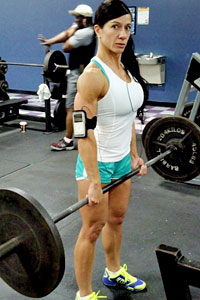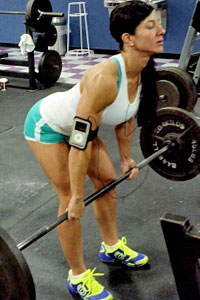Some use the names Stiff legged deadlift (SLDL) and Romanian deadlift (RDL) interchangeably, which is a mistake, because the two exercises are very different. However, both exercises do target the same muscles, which are the glutes, hamstrings and lower back, commonly called the posterior chain.

One of the primary differences between the RDL and the SLDL is that the RDL works the spinal erectors statically, because there is no movement in the spine during the exercise. In contrast, the SLDL works the spinal erectors more dynamically because of the rounding and un-rounding (flexion and extension) of the low back. The result of this movement is a great deal of undue stress on the lower back.
I’m not a big fan of the SLDL outside of light warming up and stretching. The rounding or flexion of the back in this exercise as one lowers the weight causes a high degree of stress on the ligaments of the spine. Spinal flexion in and of itself, let alone under a load, can be very damaging to vertebral disks, increasing the risk of disk herniation. Performing the SLDL with any degree of load needed to stimulate a growth and strength adaption would be a huge error.
Before we go any further, it’s been said that the RDL gets its name from a Romanian Olympic lifter who supposedly was seen performing the exercise with over 600lbs prior to winning a medal and setting a world record. Since the lifter was Romanian, the movement was dubbed the Romanian deadlift. Whether this is true or not, I’m not sure. I only know for sure what I’ve read, and have been told this story several times, and RDL is how most in the know refer to this exercise.
Compared to teaching the squat, deadlift or Olympic lifts, the RDL is easy. One starts the exercise standing with straight arms holding dumbbells or a barbell. One can use an over-under grip or double overhand. If the load is too much for the grip, which can be the case especially with heavy dumbbells, lifting straps can be used.

Keeping your back in a neutral position, start to move your hips back and lower the weight. The knees are bent slightly. While lowering the weight, it’s imperative to keep the back in a neutral position. A good way to ensure this is to perform the movement with your head up. Never, I repeat never, look to the floor while performing the RDL. The spine will follow the head. If you look down, your back will round. If the movement is performed correctly, you should feel the tension on your hamstrings.
From athletes, to bodybuilders, to powerlifters, the RDL is a superior exercise that should be included in any training program. Moderate reps of 6 – 8 are generally the best for most lifters. Higher reps can be used, but be aware of back fatigue, which can result in a breakdown of form.
It’s worth stressing that even though RDLs are known for causing severe hamstring soreness, the lower back is heavily involved. I would caution anyone squatting or deadlifting prior to doing RDLs to watch your form. The lower back can tend to fatigue and increase the risk of injury when performing the RDL in this sequence.
Related Posts
Tags: deadlifts, RDL, The Romanian Deadlift






